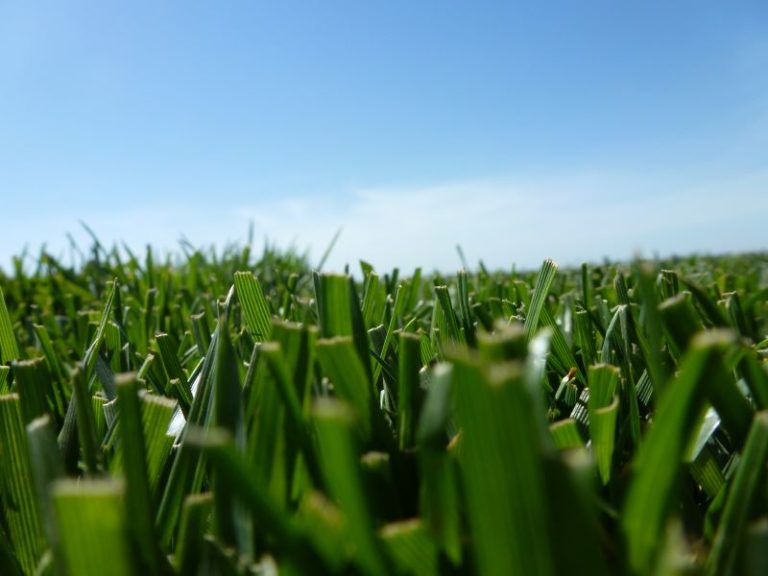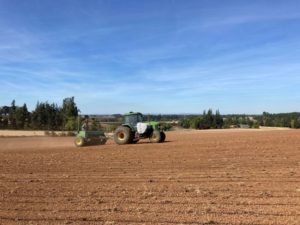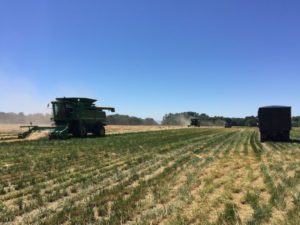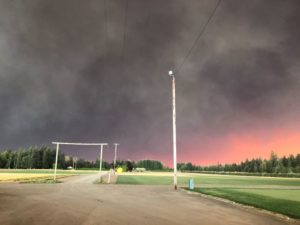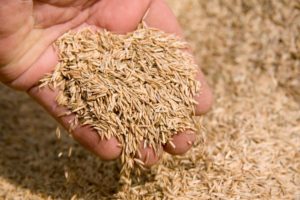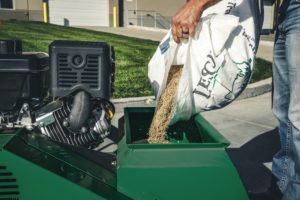In an effort to keep the pulse of the industry, SportsField Management recently reached out to industry professionals for their insights regarding current trends in the industry. For Part 3 of our coverage, we delve more deeply into the topic of the seed market. The following is expert insight regarding seed trends, current challenges, and projections for the coming year:
Pratum Seed Companies (Mountain View Seeds, and Landmark Seed)
Many are aware that 2020 brought a host of challenges to the Oregon seed industry. A gray-tailed vole endemic was followed up by wildfires in September and an ice storm in February 2021. This left many looking forward to 2021 and a new season. It didn’t take long to realize that 2021 would have its own unique challenges. Fields that were struggling to recover from voles had to endure a dry spring, which limited spring growth and nitrogen uptake. This was followed up by the hottest June and July on record, including a 117-degree record high in Salem at the end of June. This saw yields being reduced 10 to 50 percent depending on the crop, soil types, and availability of irrigation.
The drought and heat reduced yields outside of Oregon’s Willamette Valley as well. Irrigation limited losses for much of the Kentucky bluegrass crop in the Columbia Basin of Washington and eastern Oregon, but dryland production areas were severely impacted and saw total crop losses in some fields. The Peace Region of Alberta realized yields one-third of normal, adding to losses of the fine fescue crop from Oregon, and Manitoba estimates perennial ryegrass and tall fescue crops were down 60 percent. Minnesota didn’t escape unscathed and estimates a loss of 20 percent or more on perennial ryegrass due to heat and drought stress.
We expect pressures on the supply chain to continue in 2022. High pricing on commodity crops has limited the availability of new acres in Oregon, Washington and Canada. We expect stable acres in Oregon and Minnesota, a slight increase in acres in the Columbia Basin of Oregon and Washington, but a limited supply of Kentucky bluegrass from dryland areas in Washington and Idaho. Canada is also reporting lower acres of fine fescue, perennial ryegrass, and tall fescue for harvest 2022.
– Jonathan Kuenzi, seed production manager, Pratum Seed Companies
Alliance for Low Input Sustainable Turf (A-LIST)
The comments I heard consistently this fall from many in the industry were, “We’ve never seen anything like this before.” The last year represented the perfect storm of weather and crop issues combined with supply chain woes. Low yields and trucking/shipping issues hampered every facet of the grass seed industry from farm to field. Prices skyrocketed, but that didn’t mean the seed was available. When seed was available, it didn’t mean it could be shipped. Lack of containers and LTL trucks tripled pricing and extended delivery times. As we all know, seed shipments are time-sensitive, and even slight delays can often be catastrophic. The industry pulled together to do the best it could, but price adjustments happened frequently – often just days after quotes had been sent out. But there was a silver lining; relationships between seed suppliers, distributors, and sports field managers were strengthened.
As planning begins for next spring, there are several factors to consider. The move toward elite varieties is continuing at a rapid pace at the farmer level. Inferior commodity varieties are being phased out as producers realize that seed companies are willing to pay a premium for clean, high-turf-quality seed. The days of calling around for the best price may also be coming to an end. As supplies remain tight, allocations within each organization are being made. Distributors and sports field managers are now being encouraged to establish solid relationships to ensure seed availability. This past season, if the order wasn’t placed when the call was made, the seed most likely wasn’t available the next day. Establishing strong distributor relationships with the seed suppliers was one of the best ways to ensure order fulfillment. Getting orders placed in the queue as soon as possible is key to ensuring you were able get what varieties you wanted, when you want them.
While we don’t see any of the issues ending soon, we can all work together to ensure success for sports field managers across the country. Communication and early planning are key.
Some other things you can do to help ensure a successful planting season next year are as follows:
1) Establish a good relationship with your distributor.
2) Order early.
3) Consider moving to improved varieties.
4.) Talk to your seed suppliers in advance, as they will have more information that may help you plan for a successful spring.
We look forward to seeing you at the 2022 STMA Conference and Expo in January. Don’t be afraid to seek us out to discuss improved varieties.
– Jeremy Husen, executive director, A-LIST
Barenbrug
This last crop year seemed like the one where everything that could go wrong, did. Many folks in the seed industry are working on the assumption that this hole could take a year to climb out of, and acknowledge it can be hard to predict with prices as high as they are now. The current environment of crop costs and demand is conducive to a natural phenomenon in the grass seed industry, which is most often seen in ryegrass and tall fescue. Acres are easy to place, and supply can quickly swing and outweigh demand. A swing this large isn’t expected to occur in a year’s time, though, so field managers should still be on the lookout if they have crucial seed needs for the next year or two.
Depending on the end user – whether sports, golf, or lawn/landscape – a spectrum of managers set their thresholds on what cost they’re willing to invest. The overseed market experiences this the most, where some decide to have seed no matter the price or, rather, draw a line in the sand and pursue alternatives. Alternatives, in this case, almost always trickle down to other species or non-seed options entirely. With ryegrasses and tall fescue being the first dominoes to fall, bluegrass and even bentgrass are considered more during times such as these. The seeding rates of these species bring total cost well below ryegrass and fescue, but the end user must ensure these options fit their specific application.
Another way seed companies can combat the current shortage is by coating seeds with enhancements. For Barenbrug, this would include our Yellow Jacket technology. These coatings have a niche purpose, with ours improving seed survivability in high-stress environments in the peak of summer or hard-to-grow environments like interseeding. While this is an excellent strategy for meeting the needs of more customers than with raw seed alone in such a short market, raw seed may take precedent in applications that require immediate density and cover, like sod farms or the lowest height cuts of turf. When purchasing coated seed, do your homework on what ingredients are included in the product, as some may not provide any added value at all.
Recommendations I tend to make these days are from my perspective of a former turfgrass manager, not that of a seedsman. If you’re a manager who currently doesn’t have seed in hand and are looking for grass seed for annual needs, or are attempting to perform larger renovation projects, have a backup plan ready. What will you do if you cannot find any seed whatsoever? Will you be able to adjust budgets to produce a stand of turf in the coming season that meets your needs? Find out how much that scenario may cost and compare to a “with seed” budget. Does your project call for specifically adapted or unique genetics? If those aren’t available, will you be willing to settle for others that may require more inputs? In general, we see managers putting off larger projects until later seasons or shifting priorities to ensure enough high-quality fields are available to meet needs, even with the increased costs. Keeping ongoing, alternate-scenario budgets open and not pulling the trigger on large seed projects until the seed is in the warehouse can help answer questions from those to whom you report. Also, don’t give up on pursuing seed. Barenbrug is a global company, and we can use this to our advantage by sourcing seeds from other countries. While global seed is limited, we hope this might lead to mid-late season availability for various species.
– Micah Gould, market development manager, professional divisions, Barenbrug
RAS | Pure Seed
When the country shut down, millions of Americans found a new appreciation for their lawn. Retail sales of grass seed and sod began to soar. Retail stores needed more seed to stock their shelves, which led to the acquisition of three professional seed companies. Fewer companies in the professional market, plus a low carryover from the previous crop due to high demand, started the impact on the industry’s supply.
2021 crop yields have been affected by environmental factors; wildfires, ice storms, flooding, mice, excessive heat, and drought have caused all-time lows in production. Prior to the pandemic, the price of grass seed to the grower stayed relatively the same while other crop prices went up, leading farmers to take out a percentage of their grass seed acres to grow the other crops.
There have been several logistical bottlenecks that have added to the challenge of supplying seed to customers. Needing to rely on new crop to fulfill current orders creates delays due to harvesting, cleaning, testing, certifying, servicing, and packaging.
Regarding shipping, the freight industry is experiencing massive delays along with inflated prices domestically and internationally.
Our advice is to be flexible, communicate, order ahead, and forecast with your supplier. Purchasing the right coated seed will also help your ability to acquire seed sooner. Certain coatings around the seed provide key nutrients to ensure the success of germination and health of the grass. Be sure to purchase good genetics – the longevity of your project will be determined on the varieties you choose to plant. Even in a seed shortage, varieties make a difference!
– McKayla Fricker, communications director, RAS | Pure Seed
DLF North America
It is impossible to turn on the news and not hear of the increasing supply chain issues facing the country. Everything from grocery stores and retail centers to manufacturers are all having issues getting things on their shelves and production lines. Ships continue to sit in ports waiting to be unloaded, and then finding a truck to pick it up and get it from point A to point B adds to the challenges.
The seed industry is no different in facing its own challenges. 2020 saw unprecedented demand as COVID had people tending to their home lawns and buying seed in large numbers. As golf and other sports returned, it added to demand that left the industry with no carryover as we waited for the fall crop to arrive. In addition, the 2021 turfgrass crop was extremely impacted by weather. Rainfall totals were the lowest on record and some areas set record high temperatures exceeding 117 degrees Fahrenheit. The combination of drought and high heat limited yields in crops across the board.
The shortage of seed and strong demand is driving up prices to grass seed growers as they have a lot of options to choose from to take over acreage. The competition of other crops, as well as hazelnuts, are making it more expensive for growers to continue growing grass seed.
All of this, combined with shipping industry problems and labor issues, will likely continue to keep prices high as demand is still strong. It will take time to build up carryovers and supply.
The sports field manager is seeing these pressures, not only in their budgets, but also in their maintenance programs. Seed coatings are becoming an increasingly important option to consider, not only to extend supply, but also to add some benefits to the seed to assist in germination and establishment. It may also be time to consider alternative options like annual or intermediate ryegrasses instead of perennial ryegrass, or more drought- and traffic-tolerant options like tall fescue in other parts of the country.
It is important to have these conversations with your seed suppliers, as one thing is for sure – there will be no shortage in games being played and pressure on the sports field managers to keep the fields in perfect conditions at all times.
– Matt Duncan, pro turf account manager, DLF North America
SiteOne
There have been issues like severe drought in the Pacific Northwest during the last growing season and fertilizer shortages directly impacting sports turf. Seed is an elastic commodity, so we do see prices increase as supply diminishes. We anticipate the seed supply to remain very tight through the spring and then become more available after the summer 2022 crop is harvested, but we don’t think it will look normal anytime soon. Sports field managers should remain close to their distributor and sales reps. Ask them about what they’re seeing and what supplier partners are doing to stay ahead of this. SiteOne is working with customers to educate them on alternative products like enhanced efficiency fertilizers and soil stimulants to improve results with decreased seeding rates and make fertilizers work harder for them.
– Brian Rowan, VP of category management – agronomics, SiteOne


